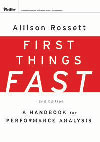Words without actions
Words without actions. That’s how I described the status of mobile learning in an article in eLearn magazine ten months ago. My point then was that mobile offers immense potential for learning and support but that it is not yet making much of a difference in the enterprise.
When San Diego State University (SDSU) colleague Jim Marshall and I surveyed more than a thousand educators in companies, agencies and universities about their eLearning practices, they reported reliance on traditional eLearning approaches, like scenarios, virtual classrooms, and online assessments. Performance support and mobile devices only rarely appeared in the organizational playbook they described. As we look at more recent data, we find an uptick for performance support, in general, but not yet for mobile delivery.
Things, finally, are changing. Now, when learning leaders call in search of talent, they seek someone with mobile experience. It’s not first on their list, but appears near the top.
I wanted to know more about what executives in learning units are thinking about mobile. Through email, I reached out to ten learning executives from diverse industries. In no way did I select them for their expertise in mobile learning and support. I sought leaders I admire for being strategic about workplace learning. No stars in their eyes, not for mobile, not for any approach. Their focus is on results for their organizations and high quality experiences for their people. This is what they said.
Mobile is not yet center stage in their enterprise learning
Not yet, but soon, is how I would characterize the responses from leaders in organizations as different as Amway and Ingersoll Rand. Comcast CLO Martha Soehren put it this way. “Mobile is becoming significant.” Those are my italics.
Steve Mehling, the US Coast Guard Admiral in charge of learning, wrote this: “We do a little with Mobile in the Coast Guard, but we’d certainly like to do a lot more. For example, we recently shifted to IPAD based instruction for most of our Leadership Development Center courses. This provides us the cost savings of not having to print course handouts and reference materials, and it provides students with quick access to other forms of research materials both in class and during off hours.”
The movement to mobile is systematic, deliberate
Andrew Wolff, PWC’s Educational Methods Leader/L&D leader for their consulting group, is certain that they are doing what they must do: laying the groundwork for success: they’ve chosen and implemented a single mobile platform to be used globally, after having proven the concept with several pilot programs. Wolff describes mobile as “another tool in the toolbox,” enabling them to deliver formal and informal learning to PWC people.
Comcast’s Soehren described where her large organization stands on mobile: “We’re working on an enterprise-wide mobile strategy as we have technicians and door-to-door sales persons who are trialing ipads and many techs already with iphones. We need to ensure that all work streams are considered: work time entry, access to employee self-service, and access to learning as well as technical on-line tools, and [access to] the knowledge base.”
Their view of what mobile can deliver includes both learning and performance support. Rob Lauber, YUM CLO, noted that they are seeking “Better understanding of how mobile device access can eliminate the need for formal training through performance support – via QR codes, location based, etc. . ..”
They value smart, skeptical designers
Most of these learning leaders are eager for instructional designers to attend to the work, worker and workplace first of all, and not to be consumed by the shiny penny that is mobile.
Rita Smith, Ingersoll Rand’s CLO, wrote of that concern, remarking that some professionals are, “Becoming enamored with a technology and then finding a learning need that fits………….needs to be in the reverse order.”
Rob Lauber also advanced that theme: “It is another delivery channel, so I expect them to understand how it can be used most effectively and where it wouldn’t be. As with most new bright, shiny objects, our profession has a tendency to over use and over play what is new. I want to avoid that. Not everything related to training/learning can now be solved because we have a tablet or a smart phone.”
Amway’s learning leader Brian Heath spoke of how technology presents opportunities and challenges, “The digital landscape is getting much more complex and so their understanding of technology must increase. They will need to have a base level of mobile knowledge in order to talk with internal stakeholders about options and why a certain approach does or doesn’t make sense. We can’t have vendors in every meeting to explain things.” I added the bolding.
These executives work in large organizations which allows them to turn to internal mobile development specialists and external vendors. It is rare for them to ask their instructional designers to take responsibility for the development of mobile solutions. What they require is great design that results in plans, storyboards and prototypes. PWC’s Andrew Wolff said that his people must: “Understand what works well on mobile (and not just any mobile, the specific profile of mobile usage that we have within our firm), consult on it, design to it, storyboard… and then pass off to a specialist who will actually do the development.”
Amway’s Brian Heath reminds that the familiar, important skills expected of learning people do not change because of the opportunities presented by mobile devices, “We don’t see anything dropping off their plates or any other current competency not being needed as much.”
This is an opportunity to shift from training to performance, from courses to accessible content and support
That’s how Darrell Walker from CA Technologies saw it. He is specific about what he wants from his learning professionals, “They will need to think more as a performance technologist and see things through the end user’s eyes, not through the content author’s eyes. Mobile is an enabler, not the end. It tends to bring about more of an expectation of a community rather than a course….” Lauber agreed, “We [learning professionals] feel attracted to the “latest and greatest” without carefully examining it for what its real potential is. Examples include elearning, social, and now mobile. We need to be smarter this time around to get it right – and more performance focused than ever.”
Several executives were eager to repurpose content, so that design effort delivers value in many ways and to many audiences. Michael Glass, with years of leadership in financial services organizations, offered this example. He described programs that he built for the sales force which the force then distributed to appreciative customers. Glass told a story that highlighted his focus on the people, not the devices. The fund managers Mike served at the time were devoted to exercising every night, with iPods stuck in their ears. He saw this as an opportunity for updates and reminders. His vision was to create an iTunes-like structure housing core content, in small nuggets, that leveraged their gusto for staying up-to-date and working out.
On the brink with mobile
Being on the brink can be good, as in being on the verge, at the threshold, soon to realize potential.
Or it can be bad, as in poised at the edge, teetering before plunging to a nasty ending or more likely for mobile, resulting in a dull thud.
The executives who responded to my inquiry are intent on a positive outcome. They appear to been keen on mobile possibilities, although not blinded by them. They know that success is not a simple matter of loading up and distributing devices. Rita Smith highlights preparation and execution. Her people must, “Understand the target audience fully to ensure mobile is the best solution. Incorporate marketing and communications to drive organizational readiness for usage. Understand the impact on design and delivery when using mobile devices versus more traditional methods. Measure and communicate effectiveness.”
Harkening back to blocking and tackling makes sense. It shouldn’t surprise us that these learning leaders emphasized systematic decisions, customer focus, laying the groundwork, and follow through even more than the development of innovative mobile apps.
++++++++
More from Allison Rossett on mobile, apps and performance support–
- Using tech to boost leader development– http://www.nxtbook.com/nxtbooks/mediatec/tm0310/index.php?startid=16#/18
- Ode to mobile performance support– http://www.learningsolutionsmag.com/articles/500/
- Claps for apps– http://www.learningsolutionsmag.com/articles/982/apps-big-help-small-price






Allison, I quite agree with you and Darrell Walker– mobile has tremendous potential for performance support in the workplace but we are not there yet. Why? The implication that learning professionals are too focussed on technology and content and not enough on the user is partly right. Another factor holding back the adoption of mobile learning is that previous implementations were too close to “the peak of inflated expectations”. Combined with a poor understanding of user behavior this led to over selling and under delivery of mobile learning. Having said that, I have seen some great mobile implementation for performance support. These have been led typically either by visionary L&D professionals or by managers and directors from elsewhere in the organization who just wanted to get the job done. Their total focus on the target audience and on performance framed the way the mobile experience was produced and that is what made it successful.
Very Good answer ………………………….
I agree with Brian Heath’s point that at the very least a “base knowledge” is needed when it comes to mobile development. When it comes to any kind of multimedia, I’ve always felt that while I may not need to be the world’s best videographer, app developer, web designer, etc, it is still important to be able to “speak the language.” I think this base knowledge goes beyond the necessity for communication purposes, too. We need to know if the new app we’re dreaming up is really worth the expense and actually going to improve our training. When it comes to mobile development, I’ve heard far too much “wouldn’t it be nice” or “wouldn’t it be cool” and not enough “you know how a mobile app would really add value to our trianing…”
I agree with Ara: mobile development is most effective for performance support. Otherwise, it’s just an added expense for the majority of learning materials, which can only be justified by actual learner demand for on-the-go (not be confused with just-in-time) access and not through top-down strategy meetings. The real benefit of the technology doesn’t require implementation: revisiting your materials to ask the question, “What portion of the content is effective and what is bloat.”
Thanks Allison for such a wonderful compilation. This has given some wonderful insights on what’s holding back many organization to adopt mobile learning to full fledge as well as highlighted the boosters.
I work for Mobile Engagement Platform company in India, and have often experienced that customers do start off with mobile learning but later slow down due to lack of mobile-centric content. Mobile learning is not about e-learning on small screens. So a helping hand in content is also required.
Once again thanks for inside feedback on the mobile learning trend.
Very nice validation of an HBR blogpost from this past July (http://blogs.hbr.org/cs/2012/07/the_future_isnt_about_mobile_its.html). As I commented there, the evolution of mobile will need to focus on MOBILITY and STRATEGICALLY understanding UX demands. It’s seeing the tech as the enabler, not the solution. With proper ANALYSIS, business results CAN happen.
Thanks for the article. And I’m gonna toss in a few thoughts…
I truly believe most institutions hurt themselves, because they’ve only structured for instructional designers. These have their purpose, and a great one, but very few consider that there needs to be a person(s) that is there for the day-to-day, who knows the technology, who can work with the technology.
I believe it’s wrong to TEACH a professor a way and then leave them to it. Professors and teachers are there to expound content, and I believe it’s backwards to expect them to both know their stuff, deliver their stuff, and also be a one-man crew. But it’s also bad to think an instructional designer can fill that role, too.
Corporate applications for performance support may be hindered by efforts to protect corporate knowledge assests. Security for applications and proprietary information must remain in the forefront. Do you really want your corporate sales strategy on an account representatives personal phone? That’s a big risk.
At Notre Dame we hosted a day-long Mobile Summit for faculty and staff to discuss ways of integrating mobile into classroom learning. The response was tremendous, and the support and thoughtfulness needed to correctly implement it shows that we are trying not to rush into it blindly or haphazardly.